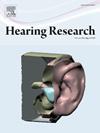网状层运动对行波的贡献:一种WKB方法
IF 2.5
2区 医学
Q1 AUDIOLOGY & SPEECH-LANGUAGE PATHOLOGY
引用次数: 0
摘要
光学相干层析成像(OCT)实验表明,在低刺激水平下,网状层(RL)的运动可能大于基底膜(BM)的运动,表明RL运动对慢行波(TW)发展的贡献可能是相关的。在本研究中,使用了一个在每个耳蜗异位处具有两个力学自由度的传输式耳蜗模型,其中外毛细胞(OHC)力由与OHC伸长成比例的低通滤波弹性项表示。该模型还考虑了峰值区流体聚焦和粘性阻尼的水动力效应。在模拟中,RL运动对行波的贡献是由于Corti器官(OoC)的体积变化,它加起来是与BM运动相关的两个尺度的反对称体积变化。将RL运动包含在WKB框架的局部波数计算中意味着聚焦因子和导纳实部的变化,这取决于相对RL- bm运动的相位。为了使RL对聚焦的贡献最有效,BM和RL在峰值区域应近似同相,在模型中,这与峰值区域流体聚焦对热盐内力的增益效应占主导地位相一致。RL-BM局域相移的负/正符号意味着额外的阻尼/抗阻尼效应,这更难以预测,并且依赖于模型。本文章由计算机程序翻译,如有差异,请以英文原文为准。
Contribution of the reticular lamina motion to the traveling wave: a WKB approach
Optical coherence tomography (OCT) experiments showed that, in the peak region, at low stimulus levels, the motion of the reticular lamina (RL) may be larger than that of the basilar membrane (BM), suggesting that the contribution of the RL motion to the development of a slow traveling wave (TW) could be a relevant one. In this study, a transmission-line cochlear model with two mechanical degrees of freedom at each tonotopic place is used, in which the outer hair cell (OHC) force is represented by a low-pass filtered elastic term proportional to the OHC elongation. The hydrodynamic effects of fluid focusing and viscous damping in the peak region are also included in the model. In the simulations, the contribution of the RL motion to the traveling wave is due to the volume change of the Organ of Corti (OoC), which adds up to the antisymmetric volume change of the two scalae associated with the BM motion. Including the RL motion in the computation of the local wavenumber in the Wentzel-Kramers-Brillouin (WKB) framework implies a change of both the focusing factor and of the real part of the admittance, dependent on the phase of the relative RL-BM motion. To make the RL contribution on focusing the most effective, the BM and the RL should be approximately in phase in the peak region, which, in the model, is consistent with a dominant gain effect of fluid focusing over OHC internal force in the peak region. The negative/positive sign of the RL-BM local phase shift would imply an additional damping/antidamping effect, which is more difficult to predict, and model-dependent.
求助全文
通过发布文献求助,成功后即可免费获取论文全文。
去求助
来源期刊

Hearing Research
医学-耳鼻喉科学
CiteScore
5.30
自引率
14.30%
发文量
163
审稿时长
75 days
期刊介绍:
The aim of the journal is to provide a forum for papers concerned with basic peripheral and central auditory mechanisms. Emphasis is on experimental and clinical studies, but theoretical and methodological papers will also be considered. The journal publishes original research papers, review and mini- review articles, rapid communications, method/protocol and perspective articles.
Papers submitted should deal with auditory anatomy, physiology, psychophysics, imaging, modeling and behavioural studies in animals and humans, as well as hearing aids and cochlear implants. Papers dealing with the vestibular system are also considered for publication. Papers on comparative aspects of hearing and on effects of drugs and environmental contaminants on hearing function will also be considered. Clinical papers will be accepted when they contribute to the understanding of normal and pathological hearing functions.
 求助内容:
求助内容: 应助结果提醒方式:
应助结果提醒方式:


